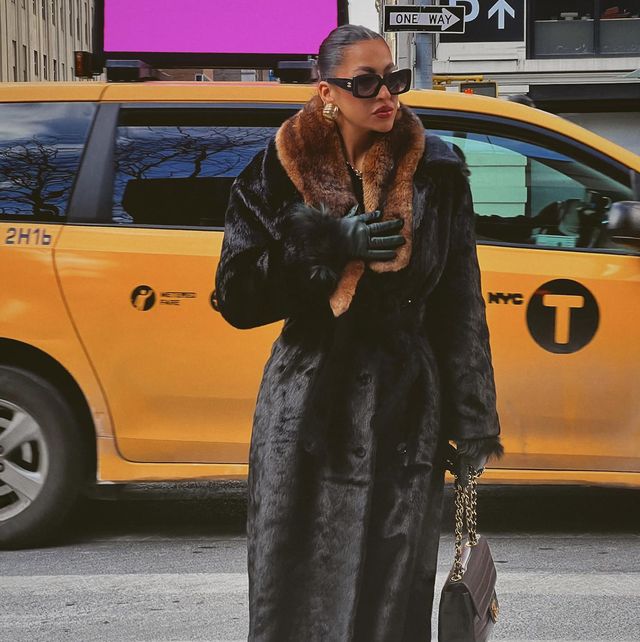Is the Mob Wife Aesthetic Promoting an Unsustainable Fashion Ideal?
In recent years, consumers have become increasingly conscious of their choices and so the dilemma between vintage fur and faux fur becomes a focal point in the quest for sustainability and ethical fashion.
It goes without saying that the fashion landscape changes daily; and the ethical considerations surrounding the use of fur have been at the forefront of debates for years. Social media trends are partly to blame for this conversation “trending” once again and with the recent rise of the mob wife aesthetic all over social media and searches for the hashtag #mobwifeaesthetic on TikTok amassing 173.8m views so far; with creators showcasing mob wife, hair and beauty as well as fashion, it is no wonder that we are debating the ethics of fur once again. Fashion creators far and wide are digging our their “mum’s old fur from the 80’s” as stated by Tiktoker @ambi.lyn; but like so many of these micro trends we are seeing, how long will the fascination last?
The Ethical Dilemma of Vintage vs. Faux Fur
Those advocating for vintage fur argue that wearing second-hand fur is a more sustainable and ethical choice than supporting the production of new faux fur. One key point in this argument is that vintage fur items already exist and are circulating in the market, so purchasing them does not contribute to the demand for new fur production. This stance aligns with the principles of circular fashion, promoting the reuse and repurposing of existing garments.
Moreover, vintage fur enthusiasts assert that by giving a second life to these pieces, one appreciates the craftsmanship of bygone eras and contributes to the preservation of fashion history. Supporters of this perspective often highlight the durability and longevity of well-maintained fur garments, arguing that they can outlast multiple faux fur items.
However, the vintage fur market is not without its critics. Opponents argue that the very act of wearing fur, regardless of its age, perpetuates a culture that normalises the use of animal products in fashion. Moreover, it can be challenging to verify the origins of vintage fur, potentially perpetuating the cycle of demand for newly produced fur.
What Is The Appeal of Faux Fur?
On the other side of the spectrum, faux fur has gained immense popularity in recent years, largely due to its cruelty-free appeal. Faux fur provides consumers with a guilt-free alternative, eliminating concerns about animal welfare and supporting a more sustainable future. The synthetic materials used in faux fur also reduce the environmental impact associated with traditional fur farming.
Global fashion brands, including many prominent ones in the UK, have embraced faux fur as a response to consumer demand for cruelty-free fashion. Notable fashion houses such as Stella McCartney have led the way in promoting synthetic alternatives, citing both ethical and environmental reasons; and even Canada Goose, known for its fur-trimmed parka jackets, is putting an end to the use of real fur in its products. The faux fur movement aligns with the broader industry trend towards sustainable and vegan fashion.
However, the ethicality of faux fur is not without its caveats. The production of synthetic materials comes with its own set of environmental challenges, as the manufacturing process can involve the use of non-renewable resources and chemicals. Additionally, the longevity of faux fur items may be questioned, as they may not withstand wear and tear as well as their genuine counterparts.

Navigating the Ethics
As consumers grapple with the ethical implications of their fashion choices, it is crucial to recognize that the decision between vintage fur and faux fur is not a one-size-fits-all proposition. Understanding the nuances of each option allows individuals to make more informed choices aligned with their values.
For those who lean towards vintage fur, a commitment to sustainable fashion involves thorough research and verification of the fur’s origin. Transparency from sellers and a growing market for certified vintage fur could contribute to a more responsible consumption pattern.
Meanwhile, advocates for faux fur can push for advancements in synthetic material production, promoting innovation that addresses environmental concerns associated with the manufacturing process. Supporting brands that prioritise sustainable practices and investing in high-quality faux fur items can contribute to a more ethical wardrobe.
We don’t think that the debate between vintage fur and faux fur will ever be completely resolved, especially with the rate that social media trends tend to change. As consumers continue to become more conscientious, the evolution of both alternatives will likely be influenced by advancements in technology, changes in consumer preferences, and the ongoing dialogue surrounding ethical fashion. The key lies in striking a balance that respects both the planet and the living beings that inhabit it, fostering a fashion industry that is both stylish and ethically sound.
Share This Story
Related Posts

Is Your Home Making You Sick? Why It’s Time to Reset Your Cleaning Routine
Is Your Home Making You Sick? Why It’s Time to Reset Your Cleaning Routine How indoor air pollution and toxic products are harming your health

Did ChatGPT Play a Role in Fueling California’s Wildfires?
Did ChatGPT Play a Role in Fuelling California’s Wildfires? Alice Hartwell Credit: Unsplash Early 2025 headlines were dominated by the devastating wildfires that swept through

Is Outlet Shopping Actually Sustainable? Let’s Discuss
Is Outlet Shopping Actually Sustainable? Bianca Foley Outlet shopping and discount designer stores have long been the ultimate fashion treasure hunt—scoring past-season gems at a

Sustainable Bakeries to Visit in the UK
(Image credit: Mix Interiors) Sustainable Bakeries to Visit in the UK There’s nothing more comforting than indulging in freshly baked goods. But what if you
